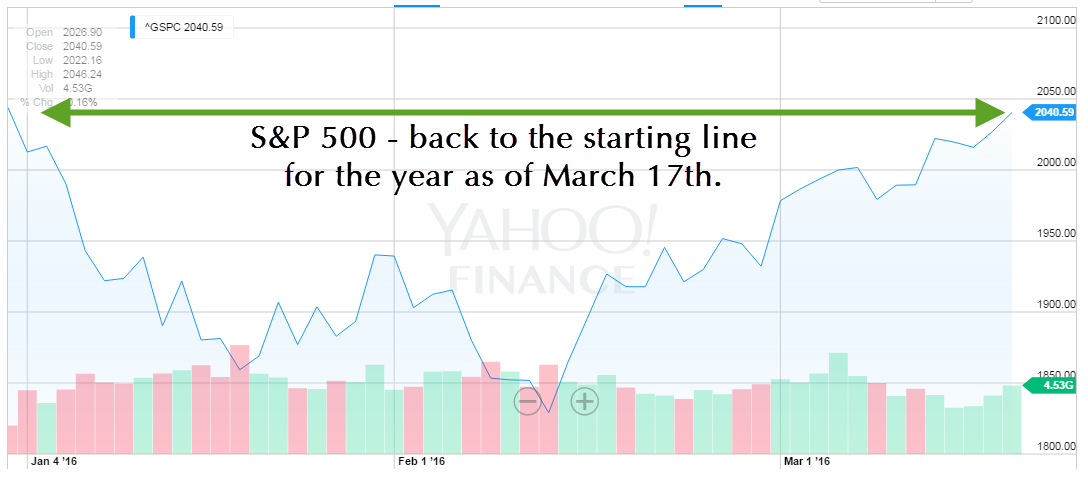March Madness in the Markets
March 18, 2016
March Madness is upon us. Basketball fans have filled out their brackets and many will be at home the next few days (or at work with the TV) watching as upsets blow up brackets and eliminate chances of winning the office NCAA pool.
Here in Central Ohio, as fans filled out their brackets, one team was noticeably absent from the 64 (or 68 if you include the Thursday games) teams in the NCAA tournament – the Ohio State Buckeyes. The Ohio State men’s basketball team got off to a rough start this season, losing three straight games in the Basketball Hall of Fame Invitational in November to supposedly inferior teams. With an overall 21-13 record and 11-7 record in the Big 10, the Buckeyes missed the cut to make the NCAA tournament. I’m guessing the Buckeyes would have loved to go back to those games early in the season and start over.

Source: USAToday.com
Like the Ohio State men’s basketball team, the U.S. stock market also got off to a bad start – the worst start to a year in history as the market was down over -8% in the first 10 trading days of the year. However, unlike the Buckeyes, the stock market is getting the chance to “start over.” Through March 17, the YTD return of the S&P 500 is essentially zero (+0.36% to be exact) meaning the market is right back to where it started the year. For many investors (at least those who did not sell at signs of trouble), it also means they have a chance to “restart” with portfolios recovering from losses they were at a few weeks earlier.

Source: Yahoo Finance
First of all, what has changed? Why has the market recovered so quickly? We would point to a few reasons:
- Economic data is not pointing to a recession. Last month, fears where high that plunging oil prices, falling interest rates, and weakening credit conditions were early signs of a recession. Since then, employment data has been strong, credit conditions have improved, and manufacturing data has shown signs of strength. Recession fears have clearly been placed on the back burner.
- Oil prices are back above $40 a barrel. Last month a client said “oil was down today so the stock market must have been too.” It’s true – oil prices and the stock market were moving almost in lockstep as oil prices dropped $27 a barrel in mid-February. Plunging oil prices prompted fears of energy company bankruptcies which would leave banks holding a bunch of bad debt. A month later, oil prices are at $42/barrel – more than a 50% recovery. With oil prices recovering, fear has been replaced with optimism.
- Central banks have remained accommodative. In the last week the markets have seen major announcements from the European Central Bank (ECB) and the U.S. Federal Reserve. In Europe, Mario Draghi announced further economic stimulus in the form of cutting interest rates and adding corporate bonds to its bond buying program. The result was improved credit conditions in Europe and a major market rally. In the U.S., the Federal Reserve not only did NOT increase short-term interest rates, but also signaled a more cautious policy outlook which indicated just two interest rate increases in 2016 as opposed to the four which were expected at the beginning of the year. Again, the market rallied with as investors liked the idea of fewer rate hikes.
With the market recovering from negative territory back to the starting line, it of course begs the question of what to expect moving forward. The short answer is we expect more volatility, especially in the midst of what will be a contentious presidential election, but are cognizant that the economic backdrop appears much more solid than what it was a few weeks ago.
In the midst of March Madness (to further our basketball analogy) we need to decide which players to have on the field. We continue to observe trends in leadership to identify which market sectors deserve the most “playing time.” In the midst of the market recovery we have seen leadership in the form of:
- Value (dividend paying stocks) over growth stocks
- Emerging market foreign stocks
- High yield bonds
- Commodities
- Energy and industrial stocks over health care
These leadership areas, some of which are cheap and showing new signs of momentum, are what we are paying attention to as we look to what players we want on the court as we approach the rest of 2016.